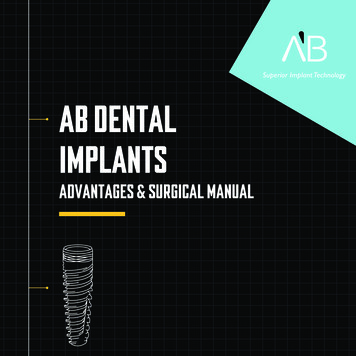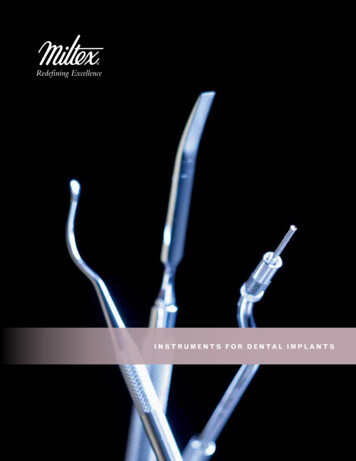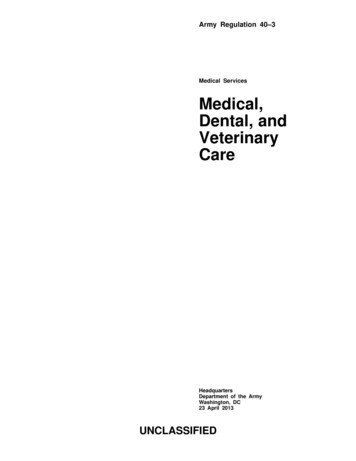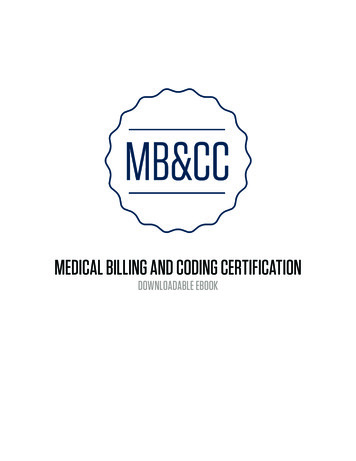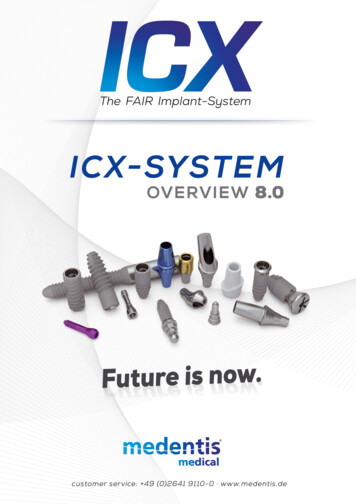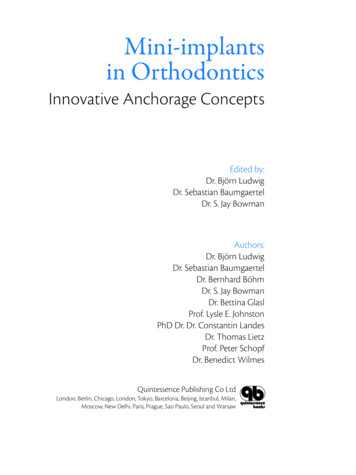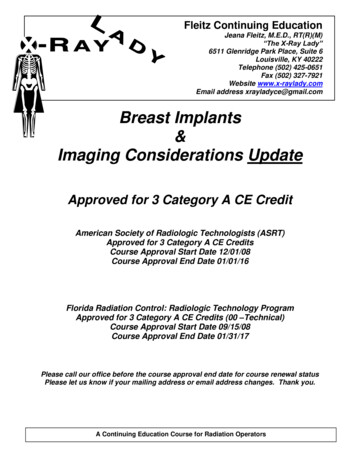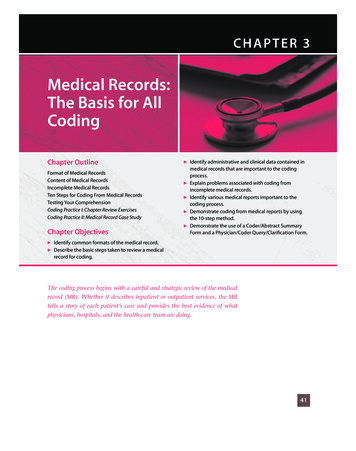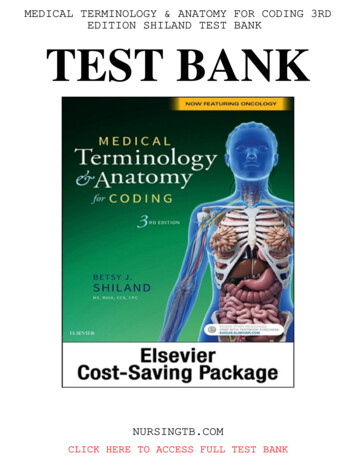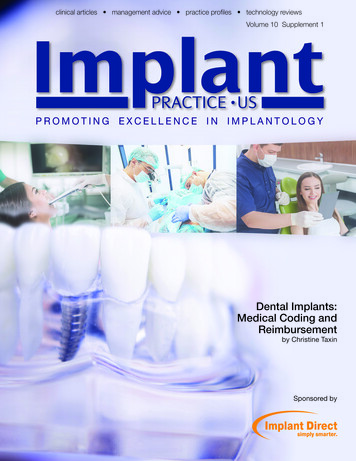
Transcription
clinical articles management advice practice profiles technology reviewsVolume 10 Supplement 1PROMOTING EXCELLENCE IN IMPLANTOLOGYDental Implants:Medical Coding andReimbursementby Christine TaxinSponsored by
PRACTICE MANAGEMENTDental Implants:Medical Coding and ReimbursementPart 1: Introduction to Medical Billing for ImplantsThe Shift to a Dental Wellness Focus and Medical BillingMany dental practices are choosing to become Dental Wellness Centers (DWC). Becoming a DWC requires a shift in practicemindset from a reparative dental model to a patient wellness focus,where emphasis is on preventive treatment as mounting researchreinforces the link between oral health and systemic disease (i.e.,links between periodontitis and conditions such as heart disease,diabetes, or stroke). When a dental practice is committed to adental wellness approach and is providing advanced treatmentssuch as placing implants, the ability to bill medical insurance withhigh confidence in reimbursement is a logical step.Medical versus Dental InsuranceAt this point in time, dental insurance provides little to noreimbursement for implants. Dentists may mistakenly think thatthey are limited to accessing dental insurance plans and that onlyphysicians and perhaps oral surgeons can bill medical insurance.In fact, dentists can bill medical insurance for any procedure ortreatment that is within the scope of their license.Implant procedures are eligible for medical billing when theymeet threshold of medical necessity. Examples include casesthat restore function by resolving a compromised ability to chew.Another example of medically necessary implant procedures arecases where oral disease complicates, or causes, other medicalconditions such as digestive or nutritional problems from impairedchewing function.Definition: Dental Wellness Center1. Patient is expert/co-manager of his/her own health.2. Capacity to address conditionings causing lossof function.3. Prioritizes risk assessment and prevention.4. Trained to bill medical and dental insurance.Comparison: Dental versus MedicalDentalMedical1. Annual maximums havenot increased in almost20 years.1. Does not usually have anannual maximum.2. Does not allow formedical conditions.2. Considers medicalconditions that affect oralhealth.3. Cases are not accepteddue to high out-of-pocketcosts.3. Higher case acceptancebehavior because of willingness to bill on their behalf.4. Some children do nothave dental insurance.4. Medical is required toprovide children 19 andunder dental coverage.Patient and Practice BenefitsEquipping your practice to support medical billing allowspatients to realize the oral and systemic health benefits of implantsaffordably, minimizing out-of-pocket expenses, and maximizingtotal insurance plan benefits. There are also many significantbenefits to the practice.Soon to be published, this comprehensive series offers apractical method for developing a successful medical billingprotocol.2 Implant practicePractice Benefits of Medical Billing Increased Practice Differentiation Superior Practice Growth Greater Patient Loyalty/Satisfaction Professional GrowthVolume 10 Supplement 1
Transforming into a wellness-focused practice capable ofbilling medical insurance has significant benefits but also requiresfundamental change on many levels. Under this new model,the dentist thinks and acts like an “oral physician.” The practiceprocesses and the entire dental team must be oriented to identifyand establish medical necessity, which is the criterion for implantsand associated procedures to be reimbursable.What is Medical Necessity?“Medical necessity is defined as accepted health careservices and supplies provided by health care entities, appropriate to the evaluation and treatment of a disease, condition,illness or injury and consistent with the applicable standard ofcare.” (http://www.acmq.org/policies/policy8.pdf)For example, with respect to implants restoring alveolarbone and preventing further bone atrophy in the presence ofother medical conditions such as digestive disorders, diabetes,or osteoporosis qualifies implants as medically necessary andtherefore billable.Medical Billing: Impact on Assessment and DocumentationTypically, a dental practice will need to upgrade and modifypatient assessment and documentation processes to uncovermedical conditions and establish medical necessity.A robust patient assessment process includes getting acomprehensive health history and risk assessment upon intake,a patient interview about their health or complaint, a clinicalexamination, diagnostic reporting, a medical risk assessmentand documentation right through treatment and follow up.The accepted process for documentation of patient encounters that has been widely adopted for communication betweeninterdisciplinary healthcare providers goes by the acronym SOAP(as in SOAP notes).Subjective: What the patients report about their health orspecific complaint.Objective: Facts that can be verified or observed duringthe exam.Assessment: The dentist’s conclusions, diagnosis, orprognosis based on the exam and/or diagnostic tests. Mayinclude theories of causation and severity.Plan/Procedure: Specific treatment that the dentist willprovide.SOAP reports, commonly referred to as SOAP Notes,should accompany medical insurance claims. In additionto being required to help establish medical necessity forclaims submission, SOAP notes will be of tremendous assistance to your insurance specialist in identifying the properdisease-diagnosis codes (ICD-10) and procedural (CPT)billing codes.A dental team that’s ready and willing to learn how to identifymedical necessity and document consistently throughout treatment will find that both routine procedures and implant casesthat far exceed expectations for reimbursement.Before Billing MedicalLearning aboutyour esHealthhistoryDiagnostictestingVolume 10 Supplement 1ReportsLetter frommedicaldoctorDiagnostictestingresultsImplant practice 3PRACTICE MANAGEMENTPart 2: Patient Assessment and Documentation
PRACTICE MANAGEMENTTypical Dental SOAP WorkflowFront Desk andClinical AssistantClinical ssmentPlan of ogyQualitySeverityModifying factorsAdditional symptomsPrevious treatmentObservationVital signsMeasurementsMedicationsFindings from examinationDiagnostic testsRead diagnostic resultsSynthesize all dataDiagnosisOutcome(with or without treatment)As practices transition from a reparative dental model to apatient wellness focus, they struggle to fit new preventive standards into outdated infrastructures. Fundamental practice workflows and dental team responsibilities often need updating torealize the benefits of making this transition. Achieving a smoothworkflow conducive to medical billing involves a series of coordinated patient hand-offs and impeccable communication.The SOAP workflow engages every member of the dentalteam and potentially includes new responsibilities. Besidesfront desk and the clinical team, implant coordinators and theinsurance specialist are key participants in a billing capableworkflow. Ensure that all mission critical functions for medicalbilling of implants (or medical billing of any dental procedurefor that matter) are formally assigned to someone. The bestway to do this is to modify written job descriptions to includenew accountabilities.Dental Team Communication and Enhanced RolesThe Patient EncounterOne communication goal is providing clear accurate information and education to the patient. To that end, develop commonterminology and a consistent patient message that is delivereduniformly by all team members. The other key communicationgoal is to ensure that vital information is transmitted to the nextteam member across each phase of the practice’s SOAP process.The model patient encounter begins while the patient isshopping for dental services. Ensure that your marketing material, such as your website, should explain your Dental WellnessCenter approach and how you can help maximize insurancebenefits. It extends all the way through the clinical exam, diagnosis, and presentation of the treatment plan to the patient.Part 3: Updating Practice Workflow and DentalTeam ResponsibilitiesSuccessful Treatment PlanningDentalmedicalhistoryOral udymodelsSoft andbone tissuesnaturalteethTransitionalsdiagnosticwax up smilelineRadiographsBone volumebone densityType of prosthesisNumber of implants4 Implant practiceBone augmentationVolume 10 Supplement 1
Part 4 Coding Procedures for Medical BillingIs This Procedure Billable?In general, there are four broad categories of billableprocedures. Diagnostic Medical (nonsurgical) treatment Surgical treatment Traumatic injury to the oral cavityIf you can answer “yes” to one or more of the quick screeningquestions below, you can likely bill medical insurance: Is this patient suffering from loss of function? Is the condition due to a traumatic injury? Is there inflammation or an infection? Does the diagnosis involve a related medical conditionother than the immediate dental problem? Is this patient having hip, knee replacement surgery, orchemotherapy? Will the patient need oral surgery?A “no” answer does not definitively mean that the proposedtreatment cannot be qualified for medical insurance. It just meansthat some other circumstance must create medical necessity.There are three main coding systems used when billing apatient’s insurance, which are: CDT — Current Dental Terminology codes ICD-10 — International Classification of Disease 10thedition codes CPT — Current Procedural Terminology codesVolume 10 Supplement 1Selection of CodesThe selection of ICD-10 codes should fully describe thediagnoses of presenting symptoms and conditions that justifythe tests and proposed treatments or procedures. There mustbe a diagnosis code for medical reimbursement of any procedure; typically, there will be several. The SOAP workflow anddocumentation process enable the selection of ICD-10 codesencompassing: A primary diagnosis Secondary or supporting diagnoses Signs, symptoms, or medical conditions that co-exist andexacerbate, or are exacerbated by the primary presentingconditionProper selection of ICD-10 codes for both primary andbackup diagnoses, which establish medical necessity ofthe implant procedure, is critical to successful billing andreimbursement.CPT codes include evaluations, diagnostic tests, medicalprocedures, surgeries, and other therapies. In conjunction withICD-10 codes, CPT codes describe the entire medical encounterto the payer. They identify specific services rendered, proceduresperformed, and/or supplies consumed during the encounter andmake a request for reimbursement from the insurance provider.For the most current and complete CPT codes, modifiers,and their proper use, consult the CPT 2017 Professional Editionpublished annually by the AMA (available at tDetail.jsp?product id prod2730006&navAction push). Your practice should own and usethe edition of the AMA code book consistent with the claimdate of service.The final hand-off is to thefinancial coordinator orinsurance specialist whoshould be ready to presentpayment options to coverthe patients expectedout-of-pocket expenses.Implant practice 5PRACTICE MANAGEMENTElements of a complete treatment plan presentation shouldinclude: Pros and cons of the recommended treatment Pros and cons of alternative treatments Prognosis — expected outcomes Potential complications and risks Maintenance of implants, including home-care regimensIt is generally good practice, but especially important whenoffering medical billing support that the treatment plan presentation disclose: The expected outcome and cost if the patient undergoestreatment The expected outcome and cost if the patient declinestreatment The prognosis, treatment required, potential cost, andother complications of postponing treatment (includingany implications for underlying medical conditions)This disclosure keeps your documentation legal and compliantalong with having the patient own his/her illness.The final hand-off is to the financial coordinator or insurancespecialist who should be ready to present payment options tocover the patients expected out-of-pocket expenses, which mayalso include pre-qualification for a third party financing company.
PRACTICE MANAGEMENTPart 5: Submitting a Clean ClaimSubmitting “clean” claims (complete and correct) isthe surest path to “first pass” success with medical billingand reimbursement. Producing consistently clean medicalinsurance claims is a function of following best practicesthat include: Following the SOAP documentation process Establishing the medical necessity of the dentalprocedure (i.e., implants and bone grafts) Verifying benefits and payer information requirementsupfront Selecting appropriate ICD-10 and CPT codes Submitting all required documentation including: Letters of Medical Necessity Operative Reports CMS-1500s that are correct and accurateFor maximum efficiency in the billing process, theimplant coordinator or insurance specialist must understand the patient’s benefit plan and special payer information requirements upfront. It must be established whetherimplants are a covered benefit or specifically excluded.If benefits, exclusions, or information requirements withrespect to dental implants are unclear, the coordinator orspecialist should call the carrier. Ask the provider to providedetails of everything required for a clean claim that can beprocessed on the initial submission.During the verification step, remember to address the3P’s; that is, determine if the payer requires pre-authorization, pre-certification, and or pre-determination.SOAP notes that document the patient encountershould always accompany a medical insurance claim.Two other type of documents, a Letters of MedicalNecessity (LMN) and Operative Reports, are typically required for reimbursement of implant procedures. A LMN is a narrative providing the rationale asto why the treatment provided should be eligible forreimbursement by medical insurance. An OperativeReport that documents the details of the surgery forthe patient’s medical records will also be required fordental implant placement and bone grafting claims.Medical Insurance for Dental ImplantsPatient presents withmedical need(complaints,symptoms, disease,disorder trauma)Dentist diagnoseswith (thoroughmedical history,comprehensive exam)Practice verifiespatient insurancebenefits (obtainsphone or writtenpre-authorization)Dentist performsimplantation andadjunctive proceduresClaim filed with necessary documentationSOAP reportCMS-1500- ICD-10 Codes- CPT CodesLetter of Medical NecessityOther supporting documentationClaim PaidClaim DeniedCompleting the CMS-1500 Claim FormThe Centers for Medicare and Medicaid Services 1500form (CMS-1500) is the standard paper claim form forbilling Medicare. In the name of standardization, manyprivate insurers have adopted or accept the CMS-1500.Be sure to ask the payer if he/she accepts the CMS-1500for claims or utilize an alternative form. In any case theinformation required will be similar. While the form lookscomplex, once the ICD-10 and CPT codes and modifiersare selected, the mechanics of filling out the form arestraightforward.6 Implant practiceReview of explanationof benefitsSend appeal restatingMedical NecessityAppeal?Alternative BillingVolume 10 Supplement 1
Billing for Medically Necessary Implant Procedures: How Much?Since medical reimbursement amounts often exceed whatcan be expected from dental plans, it’s important to evaluateand potentially adjust the practice fee schedule in anticipation ofmedical billing. It’s useful to understand what industry averagefees are for implants and related procedures (i.e., bone grafting).Fees may differ widely based on not only the procedure itself,but also based on geographic location and payer assessment ofUCRs (Usual, Customary and Reasonable fees). Fee analysis at thezip code level is best for accurate assessment of what to chargein any given practice. National fee ranges for partial and completeimplant placement procedures are shown in the table to the left.Strategies for Maximizing Dental and Medical BenefitsNational Fee RangesCPT CodeDescriptionNational Fee Range21248Endosteal implant,1-3 per jaw 3,500- 6,00021249Endosteal implant,4 or more per jaw 6,000- 9,000Think strategically about billing given that you may have theoption of billing the patient’s medical insurance and or dentalinsurance for implants and adjunct procedures. An understandingof the benefits and limits of both medical and dental plans canmaximize patient care and minimize total out-of-pocket expenses.Consider that a typical dental plan has annual maximum benefitlimits of 1,000 to 2,000. Billing implants to medical insurancecan allow for preservation of this limited dental benefit for dentalservices that are ineligible for medical billing.Final Thoughts on Implementing Medical Billing for ImplantsIt is highly recommended that practice team members handlingbilling as well as the dentist(s) attend a comprehensive medicalbilling course. The return on investment is significant and realizedwithin a few months of implementing medical billing in the practice.The satisfaction of helping your patients from a financial, dentalhealth, and systemic wellness perspective is priceless! IPChristine Taxin is the founder and president of Links2Success, a practice management consulting company to the dental andmedical fields. Prior to starting her own consulting company Ms. Taxin served as an administrator of a critical care departmentat Mt. Sinai Hospital in New York City and managed an extensive multi-specialty dental practice in New York.In addition to providing practice consulting services, Christine delivers continuing education seminars for dental and medicalprofessionals and serves as an adjunct professor at the New York University (NYU) Dental School and Resident Programs forMaimonides Hospital. She is recognized as a dental industry expert on advanced dental and medical billing techniques.As a provider of continuing dental education, Ms. Taxin has been a guest speaker for major dental industry manufacturers,the American Association of Dental Office Managers, and the New York Academy of General Dentistry among many otherorganizations for dental professionals. The AGD has approved her company Links2Success as a national provider of PACEcontinuing education credits.Disclaimer: Ms. Taxin is a paid consultant of Implant Direct. The opinions in this eBook are Dr. Taxin’s and not those of ImplantDirect. The information provided contains general reimbursement information only and is not legal advice, nor is it advice abouthow to code, complete, or submit any particular claim for payment. It is a dental practice and dentist responsibility to determineappropriate codes, charges, and modifiers, and submit bills for the services consistent with the patient insurer requirements.Third-party payers may have different policies and coding requirements. Such policies can change over time. Implant Directdisclaims any responsibility for claims submitted by dental practices and dentists. The key in all coding and billing to payersis to be truthful and not misleading and make full disclosures to the payer about how the product has been used and theprocedures necessary to deploy and remove the product when seeking reimbursement for any product or procedure.Volume 10 Supplement 1Implant practice 7PRACTICE MANAGEMENTPart 6: Advanced Billing Topics
For the most current and complete CPT codes, modiiers, and their proper use, consult the CPT 2017 Professional Edition publ
